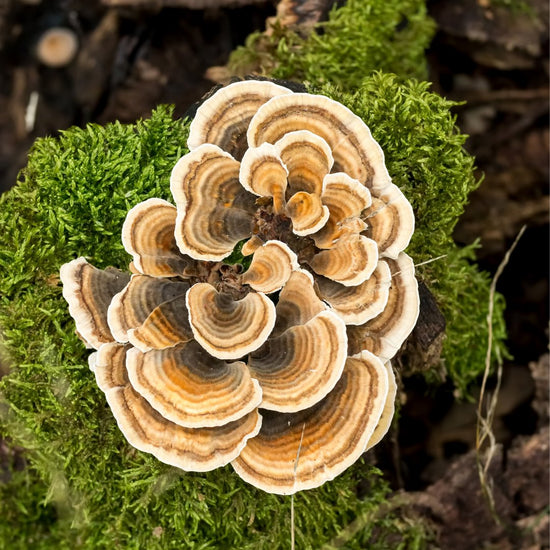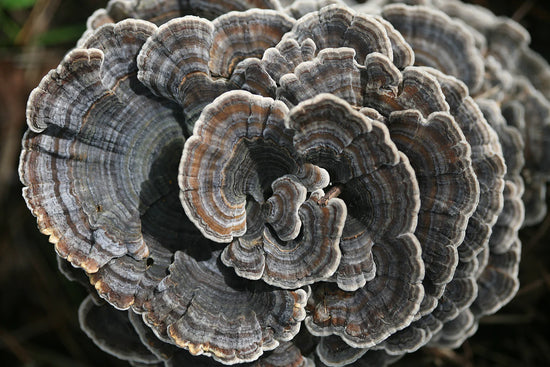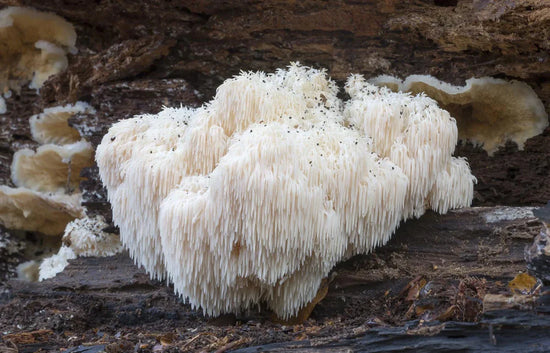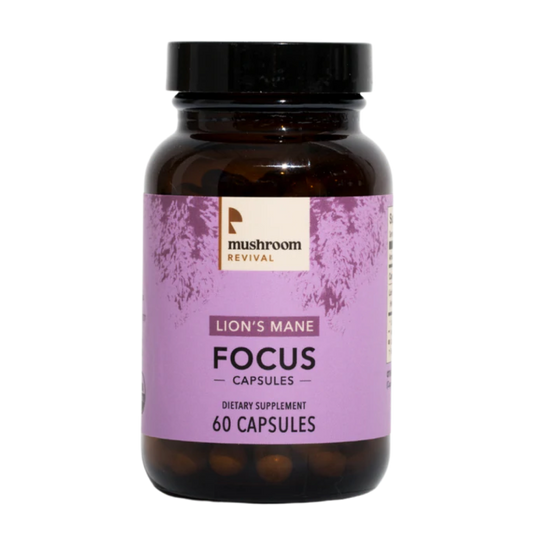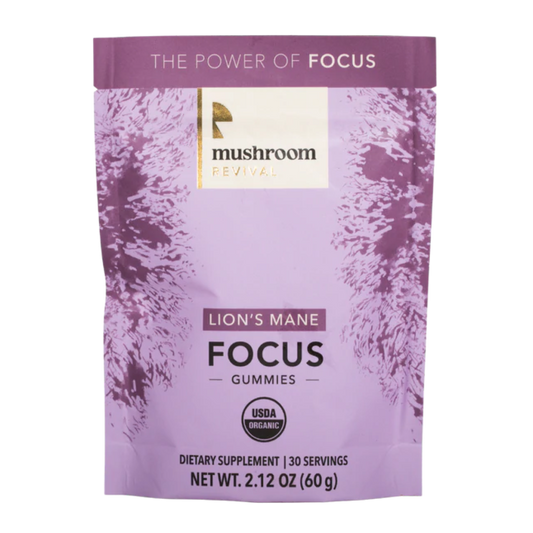What Fungi Reveal About Multicellular Life
How did multicellular life evolve? We don’t know! However, fungi are helping us develop ideas about the emergence of complex life. Today we are joined by Dr. William Ratcliff, who has successfully induced naturally unicellular yeast to evolve into multicellular ‘snowflake yeasts’ in his lab at Georgia Tech. Prepare for a delightful interview featuring evolutionary history, biotechnology, semantics, philosophy, and life itself.
Dr. William Ratcliff has his Ph.D. in Ecology evolution and Behavior and runs the Ratcliff lab at Georgia Tech and is the Co-Director of the Interdisciplinary Graduate Program in Quantitative Biosciences.

Topics covered:
- The difference between multicellular life and single cellular life
- What is an organism?
- Evolutionary trends and novelties in multicellular life
- Catalyzing multicellular life in vitro
- Why yeast— specifically saccharomyces cerevisiae — are so widely used in genomics research and biotechnology
- The Ratcliff Lab’s development of multicellular yeasts dubbed ‘snowflake yeast’
- Mechanistic basics of multicellular yeasts, particularly entanglement
- Prototaxites and its characteristics of entanglements
- Cellular differentiation and cellular suicide in evolving snowflake yeasts
- Reversing multicellular evolution
- Cyanobacteria, Bangiomorpha pubescens and other early forms of multicellular life
- Ways that multicellularity can be expressed
- Myxococcus xanthus
- Acellular slime molds
- How to grow snowflake yeast at home!
Show notes:
The Ratcliff Lab: https://ratclifflab.biosci.gatech.edu/
Grow your own multicellular yeast: http://www.snowflakeyeastlab.com/the%20kit.htm
The Biophysics if nascent multicellularity: https://www.youtube.com/watch?v=-WwBiBUcKG4
William Ratcliff’s Publications: https://scholar.google.com/citations?user=wdVRIS0AAAAJ&hl=en
TRANSCRIPT
You're listening to the mushroom revival podcast.
Will 0:07
Close your eyes. And imagine just your favorite deep woods, there's filtered light come down your face, you hear the chirping of birds and the trees above you. So behind that lower tone is throwing of insects, let's start removing the multicellular organisms that are part of this environment. So let's remove the plants, the trees, the shrimps, the small flowering plants. Poof, they're gone. You hear a flapping of wings as the as the birds fly away or rain insects as they fall out of the sky above you. Those are clearly animals. So get rid of those. What do we have left? We have the fungi. That was you know, mycelium mats. There's there's, there's mushrooms, there's lichens, those are all multicellular organisms, get rid of them. In this terrestrial biosphere. If you've gotten rid of plants, animals and fungi, you're kind of left with a wetter greener version of Mars where you know, the surface of the soil will be fully colonized with lots of different diverse single celled organisms. But it's a fundamentally different environment than the one that we have now, which has been sculpted by all this island.
Lera 1:12
While we don't know for certain what the first multicellular organism was, scientists are confident that as cyanobacterium was one of the first successful organisms to evolve into multicellular life. And we know that fungi were instrumental to cyanobacteria and evolving more complex life such as lichens. But how did early multicellular life arise?
Alex 1:35
So, today on the show, how fungi are helping us learn more about the emergence of multicellular life, we're joined by Dr. William Radcliffe, who studies ecology, evolution and behavior, and in his lab created multicellular life from naturally single celled yeast. If you've ever wondered how single celled organisms evolved to be our walking, talking, eating 37 trillion cell human meet su fungi might have the answer.
Lera 2:23
Is there any organism we could see in the macro world? That's a single cell?
Will 2:29
Oh, that's a good question. Yes, there are a small number of visible single celled organisms, there's a few very large bacteria that are, you know, millimeter scale and have, they've just like amped up the number of copies of their chromosomes that they have. There are things that sort of blend the lines of what we would consider to be cellular. So if you've heard of the dog vomit, slime mold, it's an a cellular slime mold. So meaning basically, it's, it's like a weird way of doing what the singularity, but many, many cells come together, but then they dissolve their cellular membranes. And so it's this large, you know, can be dinner plate sized sensation of millions of nuclei. But it's really kind of technically one cell because there's no boundaries between the cells. But for the most part, if it's single celled, you can't see it.
Lera 3:16
I would love to start with the fundamental differences between multi celled life and single celled and I feel like the, the answers in the name, you know, there's more than one cell garden with one organism. But is there anything else that you think is worth bringing up about that difference?
Will 3:34
Absolutely. At the sort of very basic level, I think we all have a kind of heuristic understanding of this. That's fairly accurate, right? single celled organisms are organisms where you know, the whole creature, the whole entity is one cell. So like an E. coli bacterium, or, you know, a single baker's yeast cell, those are organisms that reproduce, they split in half you had when one cell divides, now you have two organisms, right? two cells, two organisms, and multicellular organisms are organisms that are composed of more than one cell. But this is actually not as simple as it sort of seems in the face of it. And in a sense, the term multicellular organisms is a very loaded phrase. The multicellular part, as Lera said, is pretty easy. It just means there's multiple cells and what we consider the organism. But what is an organism? That sounds like a simple, simple question, but it isn't one that has a clear or always satisfying answer. We all have a heuristic understanding of what an organism is, right? I look out my window, I see a tree I see my neighbor's dog, I see a honeybee flying around, right. These are these you know, spatially localized, groups of cells old sort of, you know, moving together as in working together as part of an organism and it's easy to to look at that and say, Look, I can put a boundary around that that's an organism but part of the problem with with thinking about what organisms are is that we're used to thinking about very well individuated organisms, you know, the dog, the tree, ours etc. And in each case, these things that I'm sort of pointing to, are clearly organisms, right? They're entities that to some extent, are the focal point of adaptation, the organism has traits which have evolved because they're beneficial. They're composed of parts. And those parts, you know, work together. And if you remove them from the organism, they don't really work so well, they tend to be broken, right? If I were to take my skin cells off of my arm, let them fall on the floor, they just die. The problem is, while it's easy to point to these traits in something like an elephant, you know what the organism has had three quarters of a billion years of evolution to adapt as a multicellular organism. It works, but it's much harder to use this here with these heuristic rules for something which is sort of in the process of making the transition from being a single celled organism to multi celled organism is actually a related concept in philosophy called the rich man poor man problem. So I'm in Atlanta, Georgia Tech. So imagine that I sort of take everyone in Atlanta and I lined them up, according to their wealth, right. And one end of the distribution, the poor person section, I'd have my graduate students who they're wonderful, they work very hard, but we don't pay them enough. Clearly poor. At the other end, I'd have you know, Ted Turner, real estate developers, people that you look at them, and you're odd, you know, they're obviously rich, and there's, there's no ambiguity, they're the extremes of the distribution. But you know, if I were to say, give you a golf cart, and say, Alright, started the poor poor person section and drive towards Ted Turner, town stop, when you get to the first rich person, you couldn't do it. Because it's a continuous process, there's no sort of natural dividing line. And the same is true from open similarity. All multicellular organisms started out their evolutionary journey as a single celled organism, over many, many, many generations, 1000s millions of generations, they evolved to form simple multicellular groups, which evolved to become more complex and the groups became the organism and the cells became the parts. So you know, rather than saying that, that multicellular organisms need a specific trait, to make them to make, to sort of show that they're multicellular, like cellular differentiation, or something, you know, we can, which works for very, very, you know, edge cases, extremes, the Ted Turner's of the multicellular world elephants, you know, redwood trees.
Rather than doing that what we're doing in our lab is sort of looking to the process. And that's more analogous to saying, alright, I can tell that I'm in the golf cart going towards richer people, because I can see that people are getting richer, I can see that, you know, this lineage, that's a simple multicellular creature is evolving to become more complex, right? If what we see that, you know, we have multi Seva groups that are the focal point of adaptation, that groups are gaining group level adaptations, and that the cells are evolving traits that make them more and more of a part, then it's clear that they are evolving in the same way that all multicellular organisms do. But it's a difficult problem that is sort of deceptively simple. Like, yes, I should be able to look at an organism and know if it's an organism or not. And that's true for the things that we're sort of used to things that have been around for half a billion years as organisms, but it's not really true for things that are sort of making the first tenuous steps in the direction of, say, multicellularity. And I know the answer is too long already. But I just, I'm gonna make one more connection here, which is that classification in biology is a really hard problem. It's not just a problem of organisms, it's sort of a general problem of the field. So you know, we still argue today, in some cases, quite bitterly about what a species is. And when we know that two separate populations are, in fact, different species. Ultimately, this comes down to the fact that, you know, evolutionary biology is a continuous process, all life on Earth has descended from a common ancestor. So when we try to impose sort of order on this, you know, continuously varying stream of germ plasm through time, right, and we try and draw lines, bright lines and make clear definitions, we're behaving in a very human sort of OCD way, and sort of forcing something on a system that doesn't really necessarily kind of behave in that way. And so there's sort of, you know, there's issues are sort of tried to force classifications with fundamentally continuous processes.
Lera 9:16
Thank you for that analogy, and elaboration on the matter. And I'll admit, when I practice biology, I do tend to look for classifications and categorical trends. You know, I definitely have to actively remind myself that that's not the whole story. Let's let's talk about what you're doing in your lab. And then I want to ask so many more questions about your specific studies. That sounds great. Yeah, you're studying multicellular evolution with yeast, hence why you're on the mushroom podcast. But yeah, if you could just kind of give us the one on one on what you all are up to at the Radcliffe lab.
Will 9:51
Sounds great. So broadly speaking, we are studying the evolution of multicellularity by doing a form of evolutionary time travel You know, we know that multicellularity has evolved in at least 25 separate lineages on earth. And we know that because if we basically look at these different lineages, like plants, or animals or fungi, they, you know, essentially nest within a unicellular lineage, which, you know, basically, we can tell because of the sort of way in which life is related to one another, that they've separately figured out how to become multicellular. Now, in nearly all cases, nearly all of these 25 lineages, these are ancient transitions happening hundreds of millions of years ago. So we have this sort of beautiful replicat history of multicellularity evolving on Earth, which is great, because you think we could learn a lot from it. And we have, but also, it's very difficult to study those early steps, because they happen a long time ago, the type of information about sort of process evolutionary process doesn't tend to be preserved very well. And so it makes it really hard to study these very early steps of how you know, a simple, single celled organism evolves into a simple multicellular critter, and how that little motivated critter evolves to become more complex. So by doing sort of directed evolution of yeast in the lab, where we start out with single celled yeast, and we evolve simple multicellularity from them, and then we sort of push them through 1000s of generations of directed evolution, which is not that different from you know, the way that we bred dogs from wolves or wheat, from, you know, wild grasses or giant corn from small to Sunday, it's the same thing humans have been doing for 10,000 years, we can study how you know, multicellularity evolves and our basic goals to understand how, you know, again, simple little groups of cells evolved to become more complex, becoming bio physically tough, evolving cellular differentiation, and figuring out simple multicellular developmental programs.
Alex 11:48
Seeing this evolution before your eyes pretty rapidly. Did it give you any insight on what's next for us as Sapiens and the rest of multicellular cellular life?
Will 12:00
That's a really good question. I don't know if how much insight it's given me into humans, because humans are I think of a fairly, we're kind of our own thing, you know, humanity. I mean, humanity itself has changed so dramatically in just the last few 100 years, right? Where we've had several, you know, I'm not sure dozens fold increase in population size. And actually, I was just reading something yesterday about how science fiction from the late 1700s like, had no concept of technological innovation, like, yeah, they thought that, you know, around in the early 2000s, now, you know, the world would be very different, but they had no idea about sort of runaway technological process progress, because we hadn't had the Industrial Revolution yet. And that wasn't just part of the cultural Zeitgeist. You know, it was like religious warring factions that taken over the world in different ways. Like that was their, you know, imagined bizarre future. So, you know, humanity is, is its own thing, where we have had runaway cultural evolution, taking us down a path, that's, I think, very unique, and the entire, you know, three and a half billion years of life on Earth. But in terms of how it makes me think about the evolution of multicellularity as a process, absolutely. It's, it's helped me understand where the constraints are, what the catalysts are, you know, what the rules of the road are for how life sort of changes the level at which organization occurs, and how you know, cells can go from being the organism, which for billions of years, were sort of optimized to increase their reproductive success at the single cell level, and how very quickly that can be subsumed into something larger than them. And that thing that's larger than them, a multi sensory group can become the unit of selection, the sort of biological unit that becomes sculpted by evolutionary processes, and in fact, can change cells to things that are no longer very good at living on their own. And this is something which, you know, we thought for a long time was necessarily slow, necessarily difficult. You know, that would be the big roadblock and why multicellularity is only evolved 25 times and, you know, not 25,000 times, but it turns out that it's not it's something which can occur very quickly, under the right conditions.
Lera 14:11
Did you choose to work with yeast because it gave generations really quickly and you could witness hundreds?
Will 14:17
Yeah, that's one major reason. If you're going to be doing a, you know, directed evolution experiment, you want something where you can push them through a lot of generations per day. So yeast is great because it has a 90 minute generation time. And what really limits the number of generations we get per day is actually than just running out of food in our test tubes. And if we get around between five and seven generations per day, before they kind of just run out of food and stop growing. If we could, you know, keep them sort of an Akina stat or something where we're continuously feeding them, you know, we could get we could triple that number.
Lera 14:51
And if I have my if I did my homework correctly, you're doing this by knocking out a gene that regulates cell separation. So if you didn't touch the species of us they'd separated but often be single celled as as normal, but you remove this gene and now they don't separate themselves giving them the opportunity to kind of figure out how to work in tandem and then you know, double from there. Can you a talk about your methods and be why waste like is, is used as extra easy to work with and biotech, I just see saccharomyces, and everywhere when it comes to studying stuff, and like, why is that such a fantastic model organism?
Will 15:34
Absolutely. Let me answer that second question first. Okay. So, you know, I think there's a couple factors at play. And the first is sort of cultural, right? yeast is a is a incredibly important part of sort of human biotechnology long before biotechnology was a word, right? We've been making beer, we've been fermenting bread, you know, second, Meister, servicii is kind of a domesticated organism, which has been really important for humanity. And organisms like that, that are so important are things that we have on hand, where there's a lot known about them, because we've studied them for Applied reasons. And often with this funding available to learn more about them sort of the same reason that you know, maize and tobacco are workhorses of plant biology research, you know, that they're not like Arabidopsis, which is the small simple laboratory model organism for, for plant biology that we only use, because it's a great genetic model system. But we have, we built all these tools for you know, tobacco and corn maze. And so you know, once you have this ecosystem, people continue to invest in it. But on top of all that, it turns out that sacrifices ever see a baker's, this is just almost a perfect model organism for for genetic and cell biological research. You know, we've been using it for classical genetics for a very long time, because it turns out that it's really controllable, you can grow it as a haploid. So one set of its chromosomes, you can grow it as a diploid, two sets of its chromosomes, you can do all sorts of meeting experiments in it really easily. Like you can toggle whether or not you want them to have sex or not, depending on how you grow them, it's really easy. And it turns out that it's even really easy to do genetic experiments, where you manipulate their DNA, where you might pull out a chunk of DNA and replace it with something else, the kind of stuff that you probably heard of CRISPR doing, which, you know, sort of that CRISPR is with this this big breakthrough, Nobel Prize winning breakthrough in gene editing technology. And what's so amazing about it is that in some ways, it sort of promises, the types the ease and speed of genetic transformation, in almost any organism that we've been able to do with yeast for a very long time. So yes, it's just, you know, they're kind of don't mind having their DNA messed with, it doesn't freak him out and kill him. They're like, okay, cool, you know, and, and typically, you know, you do these things where you transform your yeast, and you, you know, try to get the trans gene DNA into several billion cells, and maybe 10, survive and have it, hey, but that's cool. If at least one works, you got your transformation, you can keep going with the experiment. So you know, if you tried to do it with mice, it would, it wouldn't really work, right. But you can do it use because there again, you know, you can fit, you can fit a billion of them in a test tube, and, you know, just do these mass transmission experiments. So, you know, not, and they have a, you know, small genome, it's only 12 million bases, 12 mega bases, it's pretty tiny. We've understood what the genes do for a long time, it's fairly streamlined. You know, I don't know if you know, this, but, you know, plant genomes, human genomes, they're really big. They're really ungainly. The genes themselves are split up on chromosomes, and there's sort of other stuff in between them. And they have and the genes like have to sort of be spliced together as RNA before they can be transcribed and turned into into proteins. So, you know, it's difficult to sort of just look at the genome of like an animal and say, Oh, I can kind of tell what this gene does, because it's all split up. And it's kind of hard work. Yeast don't really have the split up genomes. The genomes are very streamlined. They're very optimized. Everything kind of just makes sense. And so it's, you know, it was easy to do genetics in them even before we had, you know, sophisticated computers that could do all of our, you know, bioinformatics number crunching for us.
Alex 19:19
Cool. So I read this article, and I blew my mind about this theory of how cancer is reading up old genes dating back to early single celled eukaryotic organisms, and basically reversing our evolutionary clock so to speak, to make our you know, our selves act like unicellular life. And the theory is, you know, that that's why cancer is is happening and why it's so hard to treat, and think Like that. My question is, could we use CRISPR to kind of knock out those genes related to, you know, single celled organisms and become immune to cancer? Right? Because, yeah, rev those those genes that that make ourselves act all wacky?
Will 20:23
It's a good question. Yeah, that sort of cancer is a atavism hypothesis. I've read some of those papers as well. And unfortunately, I don't think it offers an easy fix. And the reason for that is that the sort of phylogenetic the older meaning genes that that evolved a longer time ago than sort of more recent genes that are preferentially expressed and cancers are sort of the genes that you that it sort of makes sense. These are the genes that have to do with just cellular metabolism, cells dividing regular cellular growth, these things had to exist, before you evolved the genes for cellular differentiation, which is the kind of stuff that tends to be tamped down in Kansas. And so if you think about it right, before multicellularity evolve, you have just cells that are doing a thing dividing, and those are the things which are preserved in cancer. And in fact, you tend to see sort of, you know, these, these, these gj pathways that are involved in say, the differentiation in inhibition of growth, right, which are much more recently evolved, those evolved in animals, you know, some some time the last 700 million years where it's just the things underlying cellular division, they're probably billions of years old. And so you know, you kind of lose the multicellular specific differentiation signals, but you maintain cellular division. Unfortunately, if you were to try to knock out cellular division, you just kill the organism. So my thoughts on the sort of cancer is atavism hypothesis or that I don't think it's wrong. But I am also not totally sure how it changes the way I think about cancer, because in some ways, it's sort of, sort of it is kind of the way it has to be, which is that if you're losing the the signals and the behavior for complex differentiation that are necessary for normal health, and you're just regaining regular cellular division, then it sort of makes sense that you're that you're specifically sort of losing more recently evolved genes, the behavior of these differentiation genes, and maintaining an earlier skill set, which is that you know, cells know how to divide.
Lera 22:28
Wow. Alright, so, yes, let's let's go take a virtual visit into Ratcliff lab. How are you? prompting these used to stick together and watch them become multicellular life? And then what is the snowflake ease?
Will 22:45
Yeah, great question. Okay, so the model system that we that we work on now is we call it snowflake east, we made that term up before snowflake became like a political buzzword, which, you know, I can't, I can't say I've been happy with the people using snowflake is an insult. But a snowflake yeast is, is an evolved simple multicellular yeast that came from a single celled ancestor, we initially evolved them. So just step back a little bit, we know that the first step in evolving with the celerity is that you just got to get a group of cells to evolve. And there's lots of reasons why this might occur in nature, you may have things that are surviving predation or other other environmental stresses. And it's better if they're in a group, there's actually all sorts of small mouth predators out there. And if things evolved to form a group, then they can be eaten, for example. Or, you know, there's a number of reasons being able to overgrow competitors for resources like light, being able to cooperate metabolism, where it's great to have a whole bunch of cells doing the same thing, or even dividing labor. rather than sort of invoke one of those specific mechanisms. We did something even simpler in the lab, which was we just selected on organism size. And we did it by selecting on essentially a race through liquid media. So if you imagine you have a test tube, and you were to sort of stir it up, and it's filled, it's just looks kind of opaque, because it's filled with a bunch of single cells, then you left that sitting on your laboratory bench, and you come back five minutes later, and you just take the bottom 5% of that test tube, and whoever is in the bottom 5% of that test to their life is spared. They go into fresh media and can continue growing. And everyone else is unfortunately brutally murdered. Which is kind of how a selection experiment works. If you're going to have a, you know, 100 fold expansion and population size every single day. That means you can only really keep 1% of your of your organisms from day to day, otherwise, pretty soon we'd be swimming in East. So. So the things which figure out how to get to the bottom first in this test tube, they're the ones that survive. And it turns out that the best thing to do to get to the bottom of a test tube, if it's sitting on the laboratory bench is to not get heavier or denser, but in fact, just form a group of cells. Groups of cells sync a lot faster than single cells in a physically analogous manner to if you Were to, you know, throw soil into a pond, you'd see it very be cloudy and very slowly settle out. If you were to throw pebbles into that pond, it's maybe the same thing, but it falls a lot faster.
So yeah, so snowflake east, if you were to sort of take one out of that test tube and look at it, you would see something which looks like a tree, or a bush or, or a coral. It's basically a branchy structure in which daughter cells are attached to their mother cells, and they're growing end over end. So sort of like imagine, you know, you've stacked up a bunch of eggs, one after the other, but they're branching. So it's not a chain, but sort of, you know, it's a branching structure of eggs that looks kind of like a coral or a bush. And that's because the only way that snowflake ease grow is by daughter cells remaining attached to their mother cells. After say the division, yeast actually sort of have this common mode of forming groups in nature called flocculation, where under certain conditions, they'll make these adhesive, proteins on the cell surface, and when they bump into each other, they stick. That is not what's happening here with snowflake east. So if we assume that sticky, the only cells that are in that group are the, you know, Daughters of the parent of the other of the cells that were already there, and their daughters and their daughters, and so on. And that's how you get these branches. It's basically mothers and daughters all attached to one another, I think you asked how these form. And it turns out that experimentally, if we select on just single cells, we get these snowflake E's popping up in our in our populations very quickly, it takes just two weeks or so for them to kind of take over and displace the unicellular ancestors. And more or less, you know, they drive them to extinction, usually, by week, three or so. And most of the time, the modifications that we see genetically, are to a regulatory gene called Ace two. And this regulatory gene turns on a suite of enzymes, which separate daughter cells from mother cells at the appropriate point in the cell cycle. So basically, these are budding yeast, so the mother cell buds out a little baby, and that baby gets bigger and bigger until it's the mother's size. And under normal conditions, it would then just kind of be popped off and float away as a single cell. And if you lose this Ace to gene, they can no longer pop that cell off. Now, rather than like starting out our experiments with single cells all the time, most of the time now when we do experiments, we just make a clean as to deletion so that we're starting, you know, replicate experiments with the same basic snowflake behavior, and then we can evolve them in parallel. And we don't have to worry about how the mode of group formation affects downstream evolutionary dynamics. We can sort of set them all up on the exact same, you know, page, they're all simple snowflakes that we can evolve in and see how, how consistent the outcomes of the experiment are.
Lera 27:48
So have a few questions about that, that interface so they don't create the enzymes to butt off. But is there like a septum there where the cytoplasm isn't exchanging as they wouldn't? Like filamentous fungi? was a
Will 28:02
great question. I love being interviewed by mycologist. That's so cool. Yeah, so so in the ancestor of our snowflake yeast, there is essentially a cell wall, because they don't really they still kind of think they're unicellular, right? They there's like the unicellular with a mutation that makes them stick together. So they don't really have any group adaptations yet. And there is basically you know, there's a bud scar, and in two cell walls, each cell has their own cell wall, and so nothing is getting exchanged. One thing that's interesting, though, is that if we evolve them for a long time period, we're doing a Long Term Evolution experiment in our lab right now, where we've, we've recently just surpassed the 1000 transfer mark, which puts us at about 5000 generations of evolution, those ones are getting a little bit different. And this is something which we need to rigorously characterize. But but we can tell already from microscopy that we've done, that we have sort of connected chains of cells, where, you know, you may have two or three cells, that where there's no cell wall material in between them. And we don't know if the if the plasma membranes are fused, and it's essentially one sort of syncytial unit, which is kind of like a hyphae. Or if the plasma membranes are, in fact, you know, touching at at the connection between the two cells. But, but it's kind of exciting because we are seeing these initial state of the organism where every cell is physiologically totally separate from every other cell. We're seeing that breakdown and we're seeing them become more integrated.
Lera 29:33
That's really awesome. And I feel like that's the moment when the multicellularity or the starts to really blur. You know,
Will 29:41
we're definitely we're definitely driving retreiving the, what's my metaphor, you were driving the golf cart towards rich, rich? Said Turner.
Lera 29:53
Yes, so there must be a plateau to how big these things can get and then what happens there? Do they just stop dividing or do they Express programmed cell death?
Will 30:02
That's a great question. So this is a problem that's sort of intrinsic to any multicellular organism, which is that initially, they're forming these multicellular groups. They have no evolutionary history of forming multicellular groups. And they're exposed to stresses now on these groups of cells that are acting on link scales that they've never had to deal with before. Right? Imagine, you know, you've probably done that thing back in the day where in camp, you and your friends like, grabbed arms and began to wave and all of a sudden, some kid got thrown 10 feet, because it turns out that waves have incredible amounts of kinetic energy, right? It's sort of the same thing happens here where you have this group of cells. And, you know, now all of these cells are pushing into each other, and they're generating strain. And, you know, go back to imagining a snowflake as a coral, or a, sort of a bushy, bushy, branchy tree. And if new cells are being added to the interior, they are pushing onto cells that are already there, they're generating huge amounts of strain on those cells. And sooner or later, you're going to have that strain get get, you know, higher than the strongest connection between or the weakest connection between a mother and daughter cell. And you're going to break a connection between cells. And that's kind of like cutting off a branch of a tree. When you break that cellular connection, there's nothing else holding it in place, and it floats away. And in fact, that's how snowflake used to reproduce, that's their life cycle. They grow until packing and do strain causes them to spontaneously burst. And they don't sort of spill their guts or anything, they just pop a branch off, they create a branch, that little branches like a baby snowflake, which floats away and, you know, then they both grow back up to about the same size. And they both sort of popcorn continue to reproduce. And so it turns out that a figuring out how to get bigger, requires that they evolve
big changes to their sort of biophysics. And this is probably something which is true for all multicellular life. Do you want to hear a little bit about the biophysics story? Yeah, cool. This is this is work that's currently unpublished, half of its published, and the other half, we're about to submit very shortly. So snowflake, he started out microscopic, just 100 or 200 cells. And I have a research scientist in my group was on both dag, who's taken on the daunting task of doing this long term experiment where we're putting them through about 5000 generations of evolution so far. Now over this time, they've all feel that 19,000 times larger, they contain hundreds of 1000s of cells per snowflake. And they're a million times more bio physically tough. These these things are macroscopic. Now, they are the size of fruit flies. And what's cool is they start undergoing multicellular adaptation right away. And it's a process that continues for the full 5000 generations that we've examined so far. So the first thing that happens, right, is that our cells evolved to become more elongate. If you sort of, you know imagined building this model of a snowflake, where you're at a sort of stack, you know, ping pong balls and try to sort of build up build a branching tree like structure, you'd find that the balls and sort of run out of space, or they'd be pushing on one another, and you couldn't build a very big before, there just was no room to add more. If you were to do the same thing with hot dogs, you'd find that you could build a much larger group because there'd be a lot more free space between the cells, they get a lot bigger before crowding would would cause a problem. Over 5000 generations of evolution are used to evolve to look like hot dogs, they started out nearly spherical at the cellular level. And after a few 1000 generations, they almost look like a hifi they you know have an aspect ratio of two to three to one. That's not the whole story, though. It turns out that having more elongate cells can result in groups that are hundreds of times larger than their ancestor. But I already told you that these things evolved to be 19,000 times bigger, right? So you know, they're becoming fruit flies, macroscopic multicellular things that you can see with your naked eye. And so they accomplish this by changing the rules of the game. You know, going back to our analogy, right snowflakes grow with branches like a tree, and when you cut a branch, the branch falls off, but you know, it doesn't break apart if you cut the branch vines, vines do something that we call entanglement, they wrap around each other. So if you want to separate one, you have to break many branches. I have extensive personal experience with trying to remove invasive English ID from my garden in Atlanta, so I can definitely attest to the toughness of violence. The snowflake is evolved to entangle their cells just like a vine. They do this partly by having more elongate cells, but also evolving changes in the location of where they bud rather than daughter Saul's daughter cells sort of being generated on the tips of the mother cells, which would allow them to grow out into open space kind of like a coral. They also start to bud from the sides of their cells making 90 degree angles. These side buds grow past other cells and began to entangle around them. So now if you want to break a snowflake East group apart, you have to tear through a whole lot of entangled cells. And this in fact, if we if you study the biophysics of the of the cluster, we've we've shown that this makes them more than a million times more bio physically tough than their ancestor. So a lot of the work that we're doing in our lab right now, is to understand the mechanistic basis of these multicellular adaptations, these changes in cellular behavior that underlie these new multicellular traits that are allowing them to get big and by physically tough. Can I just go off on a really quick tangent to it? This is short, but it's very, very related to this podcast. So you know what other cool organism apparently use entanglement for multicellularity? One of my favorite organisms in the world, proto tax IDs. You guys heard about this?
Lera 35:48
Yeah, it's one of the oldest fungus or
Will 35:50
Oh, yeah, totally. A swamp giant right. Back in the Devonian, forging 50 million years ago, right. It's a world of essentially, you know, peat bogs. They weren't really peat, but it was forests of moss. And towering above those piddly little plants. You know, the biggest plants of the day were a metre high, were these gigantic 26 foot tall fungi, right? The name prototype societies means ancient you because the first people that describe this thought these were ancient conifers. And if one of the beautiful things about them is that they're so well preserved, that we can fit thin section trunks with the prototype IDs. And you can actually see that the hyphy that are in there are wrapped around each other. So they're highly entangled. And this probably has some role in allowing them to support these just massive size of their I don't know if their fruiting bodies and that I don't know if anyone knows, do you know,
Lera 36:40
we don't? I've just been told it's like a petrified lichen Kind of,
Will 36:45
yeah, yeah, we know that there's algae, like embedded in the in the hi fi, so it's probably like an ice. But it's hard to believe that like lightning can provide enough energy to support their growth. And in fact, if you look at delta c 13 values, they're all over the place. So we know they're not just doing photoautotrophic, but also doing a fair amount of Petter trophy.
Lera 37:07
So it seems like that observing the changes in the morphology and the entanglement, do you feel like that is one of the elements for universal or unicellular life to exist? I mean, we don't really see that when we do a cross section of our skin, it looks pretty stacked and like bubbled. But
Will 37:27
yes, yes, yes. Yes. Great question. It's, I would say it's not that specific biophysical mode of adaptation is probably not universal. It's definitely not universal. And I'm not even sure how common it is. I think partly, it's because a lot of the things which evolve, you know, multicellular bodies have mechanisms of adhering cells to one another, which results in structural integrity, that doesn't use entanglement. Something certainly do use entanglement I think a lot of modern fungi still do in fruiting bodies and whatnot. So I guess I would, I would say that it's more an example of how something that doesn't even yet have a developmental program, whose that provides the ability to precisely coordinate the way that cells interact in in three dimensional space, is nonetheless able to begin, you know, changing the way the cells behave in a significant way to create innovations in both the cyber space and overcome the obstacles that we've put before them. You know, we've sort of designed this environment that says, if you can figure out how to get big, you'll survive. And if you can't, you're gonna die. And so they figure out how to get big, right? They, they sort of, you know, they're playing this evolutionary game in the lab. And, and that's cool, because it's, it's, it's surprising to us, at least, it's surprising to me, that they're able to adapt so quickly, to the selection that we put before them, and that they can sort of, you know, change their physics in such a significant way. Without having yet having a developmental program. Why do I keep coming back to a developmental program? In some ways, this, I think, is the biggest outstanding question in the field of multicellularity, which is that, you know, most modern organisms, plants, animals, fungi, seaweeds, you know, the way that cells are sort of sculpted, as the organism grows, the way that that sort of, you know, organism of traits, traits of the group, as a whole are expressed is through finely regulated developmental patterning. Right, you couldn't have a finger without, without development, right? You couldn't have a leaf blade without development, you could never mature without development. And this sort of makes sense. from an evolutionary perspective, it's the information for how to build the organism is stored in the way that developmental processes play out. Right. And it's a complex series of things. It's not just one thing, but a very important piece of this is, you know, genetic information that genes play a key role in developmental processes. And that sort of takes information about how your organism is going To grow and develop and puts it into the genome, which now is a repository of information, it's a way that you can modify that you can have mutations occurring and developmental genes, which now give rise to novelty in three dimensional organism space, right? In the traits of the organism as a whole. And, you know, you now have this correspondence between the traits of an organism genes that affect those traits and selection can act on the organism as a whole. But it can be changing the information in the genetic code through through, you know, evolution that humans can increase in frequency. And, and you can basically build up this accumulation of traits and get massive changes, right, you can go from, basically, sea cucumbers, or sponges to blue whales, in you know, a lot of time, but like, you can basically make these massive changes through accumulated series of changes, where information is being stored, at least partially in the genome. We don't have that for any newly evolved multicellular organism, we have something which is just a dumb clump of cells, it doesn't have developmental genes. And yet, what we've shown that that is not a hard limit, you can still have multicellular adaptation, even without having a sort of genetic repository for the information of the organism as a whole. And the reason for that is that you can change the behaviors of cells, which then create emergent properties in the behavior of the group. And as long as there's genes in those cells that are tweakable, through evolution, you can create these, these large and heritable changes in the properties of whole groups. And so selection can be acting on the multicellular traits and changing genes in cells that change the way that cells behave. And so this is really cool, because it's sort of a, you know, it's the first step, you'd imagine that over time, you begin to evolve a developmental system that allows you to store essentially information about the whole organism in the genome. But we don't have that yet. And yet, that's not a barrier, this process of sustainable adaptation.
Lera 42:06
Have you witnessed any signs of your snowflake yeast starting to isolate functions? So maybe like all those cells at the tip would, you know, have a designated function versus the ones in the middle? And
Will 42:19
it's a really good question. You know, one thing we're doing right now in the lab is single cell RNA seek, where we take snowflake yeast and we break them apart into single cells, and then we sequence each individual cells, their transcriptome, so all of the different mRNA that are being expressed. And that's really cool, because then it allows you to begin asking questions about how cells behave, which you can then tag specific genes and see where they express and get localization information about it. That's going to be I think, really insightful for how sort of, you know, fine grained detailing of how novel behaviors and sort of expression types evolve. But we don't really have we haven't completed that experiment yet. So I'm reluctant to say too much because things might change. As we do more. We've done like one RNA seek experiment, we're doing more right now. But in the context of sort of the above, you know, evolving these macroscopic, snowflake yeast, right, we do see some changes that are actually I think, really interesting. So I mentioned before that after a few 100 transfers, they begin to evolve this side budding trick where some cells basically butted right angle, while most continue to vote forward for their tips. Now, the interesting thing about this is that not all cells in these evolved strains, but from their sides. In fact, only a small, you know, only maybe 13 15% of the sales are side, buddy. And it seems like this is preferentially done in all their cells. And so we are examining right now the potential for cellular aging, to be co opted as a mechanism of cellular differentiation. Specifically, we're examining how in all their cells, chaperone proteins that keep sort of the whole proteome and all the proteins in the cell working normally can begin to sort of not work so well. And when they do that, this leads to what's called a, quote, misregulation of budding, it's changes where bugs are formed. And so rather than, you know, bugs being initiated on the tips of the cells, which is the normal place to go, this causes them to start being placed on the sides of the cells. So now we have you know, this genetically uniform organism, every cell in a snowflake yeast cluster is the same. But you know, younger cells are preferentially budding from their tips and growing out and expanding and open space. All these cells, which are deeper in the cluster, are preferentially budding from their sides. And this can essentially act as one of these mechanisms which drives entanglement like the vines, you know, making the whole thing strong. Another thing I haven't talked about yet is the evolution of Sigler suicide in our yeast. This actually happens pretty quickly, cells evolved suicide within you know, just the first several 100 generations so that the dead cells, the cells that died, x could have breakpoints in the cluster and you know, make it so They're cutting off their own branch, which then severs and pops off is its own little baby snowflake cluster. And this has the effect of allowing them to throw off a larger number of smaller offspring than they would otherwise. That might seem a little counterintuitive, right there to selection for large size after all, but there's two reasons that this appears to be an adaptive strategy in our environment. First of all, you know, these smaller offspring actually grow much, much faster than the big mature snowflake yeast. And the main reason for this is that the cells inside snowflake east on the interior, are starving for oxygen, and can't Aspire. And so if they break off small groups, those small groups, every cell gets oxygen, they grow really fast. And second, having a large number of offspring probably acts kind of like a bet hedging mechanism, where simply having more offspring reduces the risk that none of them will survive. One of these, you know, 99% are killed, and only 1% of the clusters are transferred to the next round events, which happened every single day. So if you only have one or two offspring is a pretty good chance that none of them will actually make it to survive the next day, you can have a larger number, then there's just a higher statistical chance that some of them will survive. Now, the other neat thing about this is that it shows how easy it is for altruistic behavior to evolve in a multicellular system. You know, we have a small fraction of the cells in each group and maybe 5%, that are willing to pay their life to increase the growth rate and reproduction of that snowflake organism that they're part of, you know, they don't think about it, this isn't a conscious decision that they make, right? It's just the math of evolution. You know, a mutation arises, which causes this behavior, and this behavior beats its competitors that don't do this. So it increases in frequency and ends up kind of taking over. It's a really, it's a highly parallel evolving trait, meaning that, you know, we've done experiments where we have 20, replicate populations, they're all started out with, you know, regular snowflake yeast with very low rates of programmed cell death. And after several 100 generations, basically all of them have evolved high rates and programs out there. So it continually evolves. Going back to sort of the broader perspective on multicellularity. This sort of shift helps us understand, you know, how groups of cells become that unit of adaptation, or kind of the organism, right, snowflake, these the group are evolving to form better groups, and the cells are becoming sort of stripped of their evolutionary autonomy. Indeed, we find that the more highly adapted our snowflake ease clusters are, right, the longer number of generations they've been going through, and the bigger they are, and the more their cells in those groups have changed themselves, to allow for them to get big. The worse off those cells are, if we genetically forced them to grow as single cells again, remember how earlier I mentioned that, you know, we started out by removing this Ace two transcription factor, which makes them grow as snowflakes? Well, what the experimenter taketh away the experimenter can give us back, so we can take our evolved snowflake, and we can jam a functional Ace to back into them. And for some lineages, it's actually for Yeah, for some lineages, this just cleanly reverts them back to a unicellular organism to even cellularity. And we can measure their fitness as a single celled organism. And you know, the longer they've been adapting as snowflakes, the worse off they are, as single cells. Now, when they get really adapted to being, you know, macroscopic snowflakes, one Ace to reversion doesn't bring the bat t to cellularity. In fact, we're working really hard to try to bring the mic units over here, because we want to do these experiments on these things with hot dog shaped cells inside budding and stuff. But it's not trivial anymore.
Lera 48:42
And if you were to take, like you said that you broke off all the cells to do this RNA seek, how do you do that? Exactly. And like, if you were to take one of those cells, and put them in their own environments, would they grow? Or would they be like, Oh, my gosh, I'm no longer part of my mother organism, I'll just die.
Will 49:02
It's a good question. Yeah, they don't just die yet. Although we haven't measured the proportion that survived this. So I wouldn't be surprised if a large fraction of them word dying. When we when we sever them, what we actually do is we use a enzyme basically a kindness to digest their cell walls. And pretty much we destroy you know, the any, that the whole group is held together by cell wall connections, that those bud scars, and so we just dissolve the entire cell wall away, and kind of just leave them as these like little spherical protoplasts and then we sequence the spherical protoplasts. So it's a pretty bizarre environment for them. I think if you baby them, you could get them to kind of regrow cell wall and then they would regrow snowflakes. But right but again, going back to my metaphor here, isolating single cells and having them just flat out die is kind of It is kind of being the Ted Turner side of rich man poor man problem, right? Like you're a really, really, really adapted multicellular creature. If you know cells are so entrenched in multicellularity, that if they isolate, they're dead. And yet, I do think we're actually on our way, one would think we're there yet, but I think we're actually going in that direction. You know, one thing that I'd like to do is continue this experiment for the rest of my professional career. I'd like to do a 30 year long selection experiment and push these as far as we possibly can to see what we can get. You know, if I don't do this, I'll, I'll look back on my life with some regrets. Because it's something that, you know, it's it's a labor of love, right? And I don't think anyone else is going to do it. And yeah, I want to, I want to see how how derived we can make our snowflake East how organismo we can make snowflake use, right what what secrets they have, I want to I want to sort of shine a light on those. And so you know what, that is one of the things that I would like to see if if it happens if they get to the point where if you break them apart, they're completely dead, that'd be really cool. But nonetheless, I think we're kind of going in that direction, where isolated cells have lower and lower fitness than their ancestor, meaning, the longer they've been evolving as snowflakes, if you bring them back to you to cellularity, using a genetic reversion. So they continue to grow as single cells, the more adapted they are as snowflakes, the worse off they are as just free growing single cells. And I find that very interesting, because that's kind of an ecological mechanism of entrenchment that, you know, you'd have something like that, if it spends 10,000 generations in a in a snowflake form, and it were to revert and go back, you know, to try to live as as in compete against regular yeast, it would just get its butt kicked, because, yeah, it did die. But it's really bad at growing as a single cell. And if if our cells evolve, you know, to essentially have more hyphae, like septation such that they are transferred resources between cells, then I would expect that if you just dissolve cell walls, they'd all just die. You know?
Lera 52:03
Yeah. And your, your comments are a good segue to one of our last questions was, is just that, like, how is this information helpful to scientists in your field? And what do you believe it could allude to? for researchers out there?
Will 52:21
That's a it's a great question. at a very high level, you know, the evolution of complex life is a major question in the both the field of evolutionary biology and astrobiology You know, it helps us understand a critical process for the, you know, for understanding how life got to be the way it is, and one that's been very difficult to study historically. And it's also important to us just as humans, right, and that it helps us understand our origins here on Earth, and has implications for our uniqueness or lack thereof, in a universe more broadly.
Lera 52:54
One more question, that might be a more fundamental, but do you know what the first organism was? That was multicellular? I don't even know if we have that. Nomex, but I'm curious if it was, yeah, protozoa or what?
Will 53:06
It's, it's a great question. Um, you know, I don't think we'll, I don't think we can possibly know what the very first one is, because it's really unlikely that it stuck around to the modern day. And you know, and looking at little micro fossils from like, two and a half billion years ago is a is a very, very difficult thing to do. And yet, there is very good evidence that cyanobacteria were multicellular as of the great oxidation event, which occurred around its event in quotes, because it took place over hundreds of millions of years. But that's kind of a long party. But this occurred yet 2.1 billion years ago, and cyanobacteria formed, you know, honest to goodness filaments with, you know, nitrogen fixing differentiation at that point. 95% Sure, I'd have to double check on the differentiation part. But for sure, cyanobacteria, we're pretty confident we're multicellular at that point. So that's probably like our oldest really, you know, really confident answer. Within eukaryotes, you know, most multicellular organisms that you think of are you carry, it's not, not bacteria, or archaea. And within eukaryotes, there's some kind of, I think, sketchy, you know, arguments that fungi remote the sailor like one and a half billion years ago, but it's really just resting on micro fossils and morphology that I think are a little hard to interpret. But the best, like really, I think indisputable, early multicity carrier is bankier Thank you morpha which is a 1.1 billion year old red algae, where we have these just amazing fossils from chert. I think it's true. Yeah, you're getting into some specific science, geology, I don't really remember but basically, rock that can be easily dissolved with acid and you can get these like, almost like as good as today cells out of them and we can you know, See these beautiful, you know, small filamentous, like red algae that look almost the same as modern day bankia, which is why it's called begi morpha. It's like, oh, it really appears not to change almost at all at 1.1 billion years, which is actually kind of a feat in its own right.
Lera 55:17
Well, I have a super basic question. And that was, have you ever seen or read about multicellularity manifest in other ways that aren't just cells sticking together? So for example, maybe the daughter cell engulfs the mother cell or maybe remains inside? I just tried to picture other ways in which it could grow?
Will 55:37
Yeah, and that's a great question. And I think actually, that that gets us something very important about multicellularity. That multicellularity is not it's not, it's not a monolithic process. And in some ways, it's almost a kind of a, it's a term that encapsulates a lot of different things, which might, in some ways be hard to compare, because they can be so different from one another. So for example, you know, we've talked almost exclusively today about multicellular organisms that essentially grow clonally, where every cell in the organism is a is a clone made of every other cell. And, you know, there's actually really good reason why clone mates probably can evolve more complex multicellular organisms. And that's why, you know, plants, animals, fungi, and the seaweeds are all clonal. But there's all sorts of other things which form you know, which have essentially multicellular groups that have organism like status. So there's all these aggregated multicellular organisms, like so, you know, the cellular slime mold dictyostelium, the a cellular slime molds, which some people don't consider multicellular, but I think that's kind of weird, because they're, they're more multicellular, and they're not. And, and even, you know, bacteria, like myxococcus Santas, which sort of hunts in these, you know, Wolf Pack types of swarms of bacteria that are shooting out massive amounts of enzymes, which degrade their bacterial prey. And then they form these multicellular fruiting bodies, when they when they want to reproduce. You have green algae, which do this weird palindromic division, where, like, one cell gets really big, and then undergoes a whole series of repeated divisions, and has a whole bunch of offspring encapsulated within a parental extracellular matrix, which is, I mean, why not, but it's pretty bizarre when you use it cell sort of doing what we were taught in intro bio, where, you know, they just cut themselves in half, then double in size, they cut themselves in half. And, you know, you can, you can have power until the division of, you know, 64 offspring, 120 and offspring and a single cell, it's, it's pretty wild. And, you know, like I mentioned before, with the, the synesthetic stuff in the ASR slime molds, you know, you have these things where you'll have millions of cells come together, or it depends, sometimes they divide and grow, but sometimes they just fuse together and lose their, their cellular membranes and form this gigantic blob, which is basically one huge cell, but it might be the size of, you know, your omelet. And in the case of some of these things, I think they're kind of like the most animal like thing that's not an animal and that they, you probably seen it's on woodchips, sometime, you know, walking around outside, you see, this bright orange thing looks like dog vomit, that's this cool, you know, dog vomit as like the slime mold. And they're, you know, completely mobile, like, the whole thing moves through foraging for bacteria and fungi, which they just, you know, shred with, with enzymes. But there aren't that many things which kind of have a life history where the whole organism runs around eating stuff, and kind of the domain of animals. And at least in the multicellular world, there's all sorts of single celled stuff that does that. But yeah, so so multicellularity itself is like a, it's kind of a weird, grab bag of different things in which we kind of say anything that has a stage in which there's a multicellular group, and the group has adaptations, is multicellular, even if, you know, they're primarily a single cell thing, which spends almost all of their time reproducing as a single cell thing, only to come together every once in a while to form a fruiting body in a multi phase phase, and then goes back to living as a single cell thing, you know. So it's Yeah, it's really diverse.
Lera 59:23
Yeah, today, we had our podcast earlier this morning about viruses, fungal viruses, and how fungi can get them to, and that's great. This whole day has just been dissolving any thing I've ever learned about biology, which is wonderful. It's why we do the podcast, you know, in left, yes, spreading the spores and getting our minds blown. I heard you mentioned in some of your talks that you sold kits for people to like mess with multicellular growth at home. Do you still sell those?
Will 59:51
Yeah, you know, it's actually part of an educational initiative. So you know, if you want to do with your kids class or even if you want to do it with your kids at home, We will send it to you for free. It's funded by the National Science Foundation as part of a grant that we have. And so you know, it's got curriculum associated with it. You'll need some of your own materials, it'd be great if you had a microscope, you'll need to figure out an incubator. You know, a lot of people can kind of like bootstrap these things, you know, you can use a aquarium heater as an incubator, incubator, or some people have, you know, chicken egg incubators, or you know, whatever. Yeah. And you can get pretty cheap microscopes that are just USB powered now for 40 bucks on on eBay. But it's sort of assuming that they're sort of, you know, some stuff in like a science classroom. But the kit contains unicellular yeast plus snowflake yeast that are viable, contains some media so you can grow them some concavity slides for looking at them. Red and Blue Label cells, if you want to do an experiment in which you, you know, feed them to rotifer, which is this voracious? You know, single celled? Actually, they're multicellular, but they're really small, voracious animal predator. That's like Gabe limited, so like, try and get a vortex of water going into its mouth. And you know, cells go in, but multis, they can't. And they have like a clear gut. So you can like look at inside their gut, count red and blue cells and see what they're eating and now serves as a mechanism of understanding how selection could favor early multicellularity. So yeah, drop me an email. It's my last name, Radcliffe, Ra t. c, Li FF at ga tech.edu. Or just go to my website and you'll get the link there, drop me an email and um, if you know if you're doing it as part of your education for I could, it could be for sort of, you know, kids, high school students or college students. I'm happy to provide to you for free.
Lera 1:01:44
So awesome. That will definitely be in the show notes for anyone who's interested in growing wonderful.
Alex 1:01:58
Big, big thank you to Dr. William Radcliffe for not only geeking out with us but for pioneering this research and making free kits for anyone interested in experimenting with well life itself. And thanks to all of our lovely, amazing, incredible beautiful listeners for tuning in, and tuning in and caring about science about fungi, mushrooms and about what we can learn from them. If you like what you hear, you can support the show and keep content like this coming by visiting our website at mushroom revival, calm and purchasing any of our functional mushroom goodies to support your energy focus, sense of calm immune system, and defense against occasional stress all with the power of mushrooms. We love mushrooms so much and we'd love you. So we want to give our podcast listeners a special discount for 10% off just enter em our podcasts at checkout that's m our podcasts, all capital letters to get 10% off.
Lera 1:03:06
You can also support us by reading and reviewing these go along way please we love to hear from you. So whether that be through an email or a review on Apple podcasts.
Alex 1:03:16
We love you so so much, much love and may the spores be with you.








